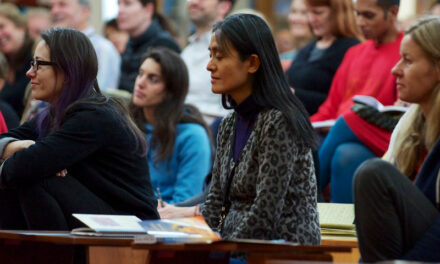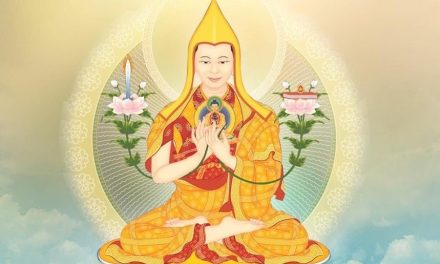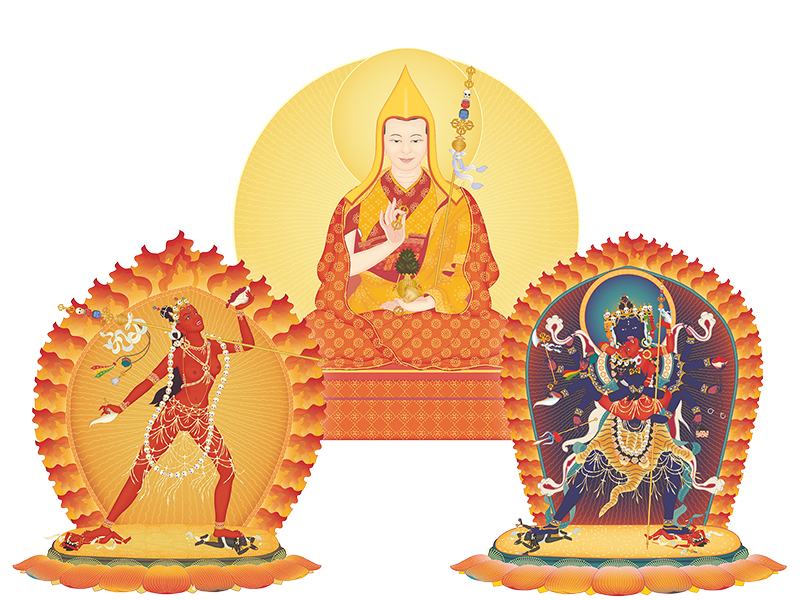Of course they are allowed to. They can do what they want.
Despite criticisms to the contrary, there is no injunction within the New Kadampa Tradition (NKT) — in the Internal Rules, the NKT books, by word of mouth, or elsewhere — against students reading non-NKT books. Geshe Kelsang’s commentaries to Je Tsongkhapa’s teachings form the basis of the three NKT study programs (the General Program, Foundation Program and Teacher Training Program, see Internal Rule 15); but outside of their studies NKT students can and do read whatever they wish. Everyone has freedom to do as they choose.
When asked about this in 1997, Geshe Kelsang replied:
The NKT people have complete choice to read whatever books they choose, to follow other teachers, and to practice in whatever way they want. There are no rules limiting people’s freedom. However, I have understood according to experience that many Westerners find themselves in conflicting situations because of following many teachers who give them opposite advice. Therefore they find serious obstacles in their spiritual path. But still individuals have choice to practice in the way they choose.
One statement has been taken out of context and exaggerated on various chat groups and forums. Thirty-five years ago an NKT Resident Teacher taught his students in a class: “You should not read books other than Geshe Kelsang’s books.” This teacher’s motivation was to help the students to pass their examination by preventing distractions arising from reading other books. However, this has never been an NKT rule or even suggestion.
Why do NKT students only study Geshe Kelsang’s books?
To respond to the related criticism that NKT students study only Geshe Kelsang’s texts and therefore not those of other great Buddhist masters, this criticism is very misleading. NKT students have access to a very full and complete Buddhist education, which includes studies of many of the great Buddhist masters.
Using the books of Geshe Kelsang as the basis of NKT study programs has a clear precedent since the earliest decades of Je Tsongkhapa’s tradition, whereby the primary texts of both Je Tsongkhapa and all the great Indian and Tibetan masters within that lineage are accessed through a curriculum of specially created study, debate, and examination texts written by one author. For example, the study programs in Ganden Jangtse and Sera Je Monasteries are written by Jetsunpa Chokyi Gyaltsen and in Sera Me Monastery by Je Khedrubje, while Ganden Shartse and Drepung Loseling Monasteries follow Panchen Sonam Drakpa’s texts.
These textbooks are the source used by students and teachers as an explanation and commentary to the works of Je Tsongkhapa and so on, and clarify the essential meaning and the interpretation of points that would otherwise be difficult to comprehend. While the monks are free to study additional texts, the actual teachings, examinations, and debates are based on the particular textbooks written by a particular author for each monastery.
This can also be considered to be the case in the NKT, where it could be said that all the NKT Dharma Centers follow the texts written by Ven. Geshe Kelsang Gyatso. These in turn are the gateway to innumerable Buddhist masters of both India and Tibet dating back in unbroken lineages to Buddha Shakaymuni, and specifically the teachings of Je Tsongkhapa and Atisha, the founders of the Kadampa tradition.
Sources
The Treasury of Lives ~ The Gelugpa Monastic Curriculum
Debate Manuals (Yig cha) in dGe lugs Monastic Colleges
Study and practice within the New Kadampa Tradition
There now follows an overview of the curriculum and texts written for the purpose of study and practice within the NKT. (For additional information, see also A Short History and Overview of the Kadampa Study Programs).
The Teacher Training Program (TTP) comprises twelve subjects based on Buddha’s Sutra and Tantra teachings and the corresponding commentaries by Venerable Geshe Kelsang Gyatso.
TTP students are encouraged to study and memorize the various root texts by previous Buddhist Masters, including:
Lamrim (Stages of the Path) outlines based closely on Je Tsongkhapa’s Lamrim Chemo, or Great Exposition of the Stages of the Path to Enlightenment.
Geshe Langri Tangpa’s Eight Verses of Training the Mind.
Geshe Chekhawa’s Training the Mind in Seven Points.
Buddha Shakyamuni’s Heart Sutra (Essence of Wisdom Sutra).
Shantideva’s Guide to the Bodhisattva’s Way of Life.
Lorig (Mind and Cognition) outlines based closely on Dharmakirti’s Commentary to Valid Cognition.
Chandrakirti’s Guide to the Middle Way.
Buddha Shakyamuni’s The Bodhisattva’s Confession of Moral Downfalls.
The First Panchen Lama’s Offering to the Spiritual Guide.
Je Phabongkhapa’s Vajrayogini Sadhana, Quick Path to Great Bliss.
Tantric grounds and paths outlines based closely on Je Tsongkhapa’s Great Treatise on the Stages of Secret Mantra.
The Heruka Sadhana, Essence of Vajrayana, based closely on the system of Mahasiddha Ghantapa.
Foundation Program (FP) students study and memorize the first six of these texts.
There are also other texts practiced by NKT students which are not part of the TTP or FP, such as:
Je Tsongkhapa’s Three Principal Aspects of the Path.
Atisha’s Advice from Atisha’s Heart.
Buddha Shakyamuni’s Praises to the 21 Taras.
Numerous sadhanas or prayer booklets composed by Buddha Shakyamuni and other past Buddhist masters.
See also The books of Venerable Geshe Kelsang Gyatso and Why does the New Kadampa Tradition sell only Ven Geshe Kelsang’s books?






I personally witnessed book by other teachers being removed, teachers removed from teaching because of quoting from texts by phabongkha and warnings against mixing traditions.
While it is allowed, it is certainly discouraged, not least of all because it is expected that any sincere student of Gyatso will become a teacher to pass on the blessings, and this must be done purely to prevent degeneration.
The author either knows the above and is disingenuously leaving the above out to claim something that is technically true but misleading due to lack of context, to avoid actually addressing the complaint while seeming to; or they are unaware of things that are common place and both written and unwritten rules of teacher training program and foundation program studies.
I am assuming this was some years ago. I have been practicing and teaching in the NKT for over 40 years and I have always had other Buddhist books as “light reading” — no one has ever told me not to and I wouldn’t listen if they did. I have never felt discouraged in reading what I want. I haven’t met anyone else in the tradition in a number of years who feels that this is an issue either.
I stick to Venerable Geshe-la’s books as the basis of my daily study and meditation practice because to me they are incredible. Likewise, Tharpa sells Ven Geshe-la’s books as the core of the three study programs. However, you can get other Buddhist books and magazines from any decent bookstore and many of my Kadampa friends do.
Plus, Je Pabongkhapa is one of our lineage Gurus, I have his books right here on my shelf too.
Many years ago an NKT Resident Teacher did say to his students in a class (and I was there): “You should not read books other than Geshe Kelsang’s books.” This advice was unskillful and has been quoted ad infinitum, but I suspect this teacher’s main motivation was to help us stay focused and pass our exam. However, other than this, in my 4 decades in this tradition, I can say that this has never been an NKT rule or even suggestion. Ask pretty much any practitioner or look at their bookshelves or browsing history, and you’ll see that they don’t only read NKT books.
Someone just asked me on YouTube if I read books by authors other than Geshe Kelsang, and I thought I may as well share my reply here as well.
Thank you for your question. I’ve been studying and practicing Buddhism for decades and read many books, but the ones I study and take to heart most deeply are the ones written by my teacher, Geshe Kelsang Gyatso, because these are incredibly clear, profound, and liberating. They have made a huge difference to my life. These books draw from all the teachings of Buddha Shakyamuni, Atisha, Nagarjuna, Chandrakirti, Geshe Chekhawa, Je Tsongkhapa, Trijang Rinpoche, and other great Buddhist masters, with nothing added or taken away, and presented in a language that I can understand and a way that I can practice.